
18.5.10
Manusia Menikahi Kucing

Pearl Carter ,Nenek 72 Tahun Yang Pacari Cucu Sendiri

Wang Xianjun Udah makan 1.500 bola lampu

Wang Xianjun, tinggal di komunitas Xitan di Linshui County, provinsi Sichuan, ia bisa dibilang "eksentrik" di mata tetangganya. Adalah umum bagi orang untuk memiliki beras atau dikukus roti untuk sarapan, tapi Wang suka makan bola lampu. Pria 54 tahun mulai makan bola lampu pada usia 12 tahun, dan telah makan sekitar 1.500 bola selama 42 tahun terakhir. Wang menganggap dirinya berpikiran terbuka.Ketika ia berumur 12 tahun, ia sengaja menelan tulang ikan, dan orang tuanya menjadi sangat khawatir. Dan lebih mengejutkan mereka, Wang tidak merasakan apa-apa. Lalu karena penasaran, ia berani mengambil sepotong pecahan kaca, dan merasa tidak ada efek samping setelah makan itu. Sejak itu, dia mulai berlatih bola lampu makan. Dia hanya berani makan sepotong kecil dari kaca di awal, tetapi dengan berlalunya waktu, dia menjadi ketagihan untuk memakannya. Namun, dia tidak makan bola lampu setiap hari. Dia kadang-kadang hanya makan serpihan bola saat sarapan, dan paling banyak, satu bola lampu setiap kali.
on Lynch ,Kakek Fungky dengan 241 Tindik

Kakek satu ini memiliki keunikan tersendiri. Penampilannya yang ekstrim membuat namanya masuk dalam Guinness Book of World Records sebagai "Pria dengan Tindik Terbanyak". Tidak tanggung-tanggung terdapat 241 tindik di wajah dan lehernya.
sebanyak 150 tindik terpasang di wajah Jon Lynch (78), sementara sisanya berada di lehernya. Pria pensiunan bank manager ini juga menambahkan tato pada wajahnya sehingga penampilannya terkesan sangat ekstrim.
Kakek yang tinggal di Apsely, Hertfordshire di Inggris ini berhasil menggeser posisi pemegang rekor dunia sebelumnya Luis Antonion Aguero dari Kuba dengan total tindik sebanyak 230. Dia sama sekali tidak percaya bahwa dirinya dinobatkan sebagai pria dengan tindik terbanyak sedunia. Kini dia bahkan berencana menambahkan tindik baru di kedua lengannya.
Lynch mengaku mulai melakukan aksi tindik menindiknya itu sejak ia berusia 50-an usai pensiun dari Barclays Bank. Pada mulanya dia menindik pada bagian alis mata yang dipasangkan cincin kecil. Namun, kini setelah tiga dekade berlalu, sudah ada puluhan deretan cincin kecil di kedua alis mata Jon Lynch.
Festival Bayi Menangis di Jepang

Seorang Pria Menikahi Mayat Kekasihnya

Air Mancur Darah

Tak Punya Tangan, Gao Baoying Menyulam dengan Kaki

Tak memiliki tangan bukan berarti halangan untuk berkarya. Gao Baoying seorang wanita asal China ini membuat berbagai macam karya sulam dengan menggunakan kakinya.
Tidak tanggung-tanggung hasil karyanya ini bahkan lebih bagus dari orang yang dibuat dengan tangan. Hasil sulamannya ikut ditampilkan dalam pameran Shanghai Expo 2010.
Pameran yang diadakan di tepi Sungai Huangpu di kota Shanghai, China dari tanggal 1 Mei sampai tanggal 31 Oktober 2010. Pameran ini juga diikuti lebih dari 190 negara.
Gao Baoying belajar menggunakan kakinya untuk melakukan segala sesuatu yang biasanya kita lakukan dengan tangan. Tidak dijelaskan apakah dia sejak dilahirkan tanpa tangan, atau karena kecelakaan. Namun satu hal yang pasti, wanita ini adalah seniman sejati.
Gao yang tinggal di Kota Tianjin, China, mulai berlatih bordir dengan kakinya ketika dia remaja. Seiring dengan berlalunya waktu, keterampilan semakin membaik.
Kini ia mampu membuat bordir paling indah, bahkan serapi buatan mesin.Sebagai pengakuan terhadap keahliannya, Gao Baoying diundang untuk menampilkan karyanya, di ajang bergengsi seperti Shanghai Expo, yang diselenggarakan beberapa waktu lalu.
25 Most Beautiful Castles in the World
Just to prove this theory to you, we’ve gathered twenty-five amazing castles from around the world for your perusal. This selection represents some of the most intriguing castles in Europe, the Middle East, Asia, North America, and from around the world. The oldest castle is being restored in Iran after an earthquake destroyed eighty percent of its buildings. The newest castle was built during this century on a stretch of private land on the Sinai coast. No matter when these castles were built, most of them are available to book for special events or as tourist venues. So, you can always visit to see if the royal lifestyle is up your alley.
Although numbered, this list is not in any particular order. So, the numbering does not indicate that we favor one castle over another or that they are listed in order of quality, size, or historic value.
Europe
It seems that you can’t turn around in Europe without bumping into a castle. Europe is the heart of pomp and circumstance, and every country holds amazing stories about their palaces and fortresses. But, if you can visit Europe only once, the following castles are on the “must see” list for your trip. Once you see them, you’ll realize that photographs don’t do justice to the sheer size and luxury that were bestowed on these current and former residences.
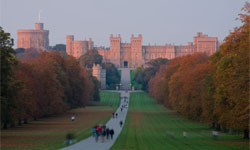 Windsor Castle: If you plan to visit England, you’ll discover that you could spend months visiting all the castles on this island. However, Windsor Castle is probably the most well known castle in the world, as - together with Buckingham Palace in London and Holyrood Palace in Edinburgh - it is one of the official residences of England’s Queen and the largest occupied castle in the world. This building and its complex have provided a home and fortress for royalty for over 900 years. Originally made of wood, the castle was built for William the Conqueror to guard the approach to London. The site sits above the River Thames, on the edge of a Saxon hunting ground and one day’s march from the Tower of London. Visitors can walk around the State Apartments, which are extensive suites of rooms at the heart of the working palace. Once you’re through with this castle, you can visit some of the top castles in Britain listed at the Travel Channel. Those castles all come highly recommended, but don’t forget to visit some of the smaller castles such as the one located in Dolwyddelan, Wales. This castle is a lovely place to visit along the road from Betws-y-Coed to the western coast and provides a chance to view Mount Snowden, the highest mountain in Wales.
Windsor Castle: If you plan to visit England, you’ll discover that you could spend months visiting all the castles on this island. However, Windsor Castle is probably the most well known castle in the world, as - together with Buckingham Palace in London and Holyrood Palace in Edinburgh - it is one of the official residences of England’s Queen and the largest occupied castle in the world. This building and its complex have provided a home and fortress for royalty for over 900 years. Originally made of wood, the castle was built for William the Conqueror to guard the approach to London. The site sits above the River Thames, on the edge of a Saxon hunting ground and one day’s march from the Tower of London. Visitors can walk around the State Apartments, which are extensive suites of rooms at the heart of the working palace. Once you’re through with this castle, you can visit some of the top castles in Britain listed at the Travel Channel. Those castles all come highly recommended, but don’t forget to visit some of the smaller castles such as the one located in Dolwyddelan, Wales. This castle is a lovely place to visit along the road from Betws-y-Coed to the western coast and provides a chance to view Mount Snowden, the highest mountain in Wales.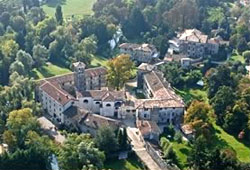 Castello di Strassoldo di Sopra: While there are more magnificent and famous Italian castles, this choice is far from the maddening tourist crowd. This castle is the ‘upper’ castle, which is located near the Castello di Strassoldo di Sotto (”lower” castle), and both castles are located in northeast Italy. Both castles also are privately owned by the Strassoldo family and have been in this family for almost one thousand years. Since they’re privately owned, they aren’t open to the public; however, the owners open their halls for two fascinating exhibits in the spring and fall each year. Additionally, important wedding banquets and other memorable events are personally organized by the owners. The castle’s splendid and fully furnished halls can host several hundred people, while the park can be used for open air buffets and wonderful photos. The owners of the Castello di Sopra have recently restored a fifteenth-century small house called “la Vicinia,” which they rent out overnight. This building and the castle are located in the heart of a lovely medieval village, surrounded by a centuries-old park that’s fed by spring waters.
Castello di Strassoldo di Sopra: While there are more magnificent and famous Italian castles, this choice is far from the maddening tourist crowd. This castle is the ‘upper’ castle, which is located near the Castello di Strassoldo di Sotto (”lower” castle), and both castles are located in northeast Italy. Both castles also are privately owned by the Strassoldo family and have been in this family for almost one thousand years. Since they’re privately owned, they aren’t open to the public; however, the owners open their halls for two fascinating exhibits in the spring and fall each year. Additionally, important wedding banquets and other memorable events are personally organized by the owners. The castle’s splendid and fully furnished halls can host several hundred people, while the park can be used for open air buffets and wonderful photos. The owners of the Castello di Sopra have recently restored a fifteenth-century small house called “la Vicinia,” which they rent out overnight. This building and the castle are located in the heart of a lovely medieval village, surrounded by a centuries-old park that’s fed by spring waters.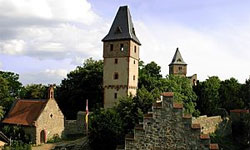 Frankenstein Castle: Darmstadt, Germany is home to the setting for Mary Shelley’s Gothic horror novel, Frankenstein. This castle was the 18th century home of Lord Konrad Dippel Von Frankenstein. There are many theories about Dippel, including one that he sold his soul for eternal life. In reality, Dippel was a highly controversial alchemist in whose laboratory the colour Prussian Blue was discovered. Maybe his enemies tried to ruin his reputation with the legend about the monster created in his laboratory. Visit Frankenstein Castle during Halloween to get the maximum scare factor, as an elaborate monster-themed theater show is performed, along with actors who lurk in the castle shadows. If this castle isn’t enough for you, you can visit a few other German castles that might tickle your luxury bones.
Frankenstein Castle: Darmstadt, Germany is home to the setting for Mary Shelley’s Gothic horror novel, Frankenstein. This castle was the 18th century home of Lord Konrad Dippel Von Frankenstein. There are many theories about Dippel, including one that he sold his soul for eternal life. In reality, Dippel was a highly controversial alchemist in whose laboratory the colour Prussian Blue was discovered. Maybe his enemies tried to ruin his reputation with the legend about the monster created in his laboratory. Visit Frankenstein Castle during Halloween to get the maximum scare factor, as an elaborate monster-themed theater show is performed, along with actors who lurk in the castle shadows. If this castle isn’t enough for you, you can visit a few other German castles that might tickle your luxury bones.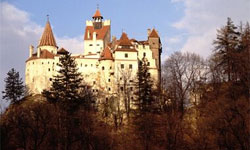 Bran Castle: This is another castle that the faint of heart might want to avoid! Commonly known as Dracula ’s Castle, the Bran Castle was originally a stronghold built by the Knights of Teutonic Order in 1212. The first documentary attestation of the Bran Castle is the act issued on 19 November 1377, giving the Saxons of Kronstadt (Brasov) the privilege to build the Citadel. The building started in 1378 as a defense against Turks and later became a customs post on the pass between Transylvania and Walachia. From 1920 the castle became a royal residence until the expulsion of the royal family in 1948. Today it functions as a very attractive museum of medieval arts. The official Romanian site will provide you with the lowdown on this country’s castles, so be sure to visit that site if you plan to visit Romania.
Bran Castle: This is another castle that the faint of heart might want to avoid! Commonly known as Dracula ’s Castle, the Bran Castle was originally a stronghold built by the Knights of Teutonic Order in 1212. The first documentary attestation of the Bran Castle is the act issued on 19 November 1377, giving the Saxons of Kronstadt (Brasov) the privilege to build the Citadel. The building started in 1378 as a defense against Turks and later became a customs post on the pass between Transylvania and Walachia. From 1920 the castle became a royal residence until the expulsion of the royal family in 1948. Today it functions as a very attractive museum of medieval arts. The official Romanian site will provide you with the lowdown on this country’s castles, so be sure to visit that site if you plan to visit Romania.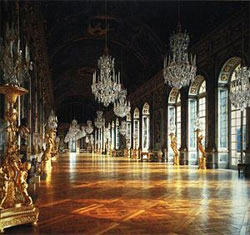 Château de Versailles: This castle complex is Louis XIV’s masterpiece, a structure so magnificent that the state treasury was almost depleted during its construction. Also known as the Palace of Versailles, and located now on the edge of Paris, this palace became home to French nobility during the seventeenth century. As the complex grew through four “building campaigns,” Versailles became the center of French government. Louis XIV lived at Versailles, and government offices, homes of thousands of courtiers and their retinues were built there, and nobles of a certain rank and position spent time each year at the court complex. Louis XIV’s attempt to centralize the French government succeeded, as few could match the ostentatious glamour represented by Versailles. Visitors now can visit this UNESCO World Heritage Site and view luxuries such as the Hall of Mirrors (pictured here) and the magnificent gardens among other features. The official Web site also contains a gallery and podcasts where individuals can learn about the castle before they actually visit. If this castle isn’t enough for you, then visit this list of French castle sites.
Château de Versailles: This castle complex is Louis XIV’s masterpiece, a structure so magnificent that the state treasury was almost depleted during its construction. Also known as the Palace of Versailles, and located now on the edge of Paris, this palace became home to French nobility during the seventeenth century. As the complex grew through four “building campaigns,” Versailles became the center of French government. Louis XIV lived at Versailles, and government offices, homes of thousands of courtiers and their retinues were built there, and nobles of a certain rank and position spent time each year at the court complex. Louis XIV’s attempt to centralize the French government succeeded, as few could match the ostentatious glamour represented by Versailles. Visitors now can visit this UNESCO World Heritage Site and view luxuries such as the Hall of Mirrors (pictured here) and the magnificent gardens among other features. The official Web site also contains a gallery and podcasts where individuals can learn about the castle before they actually visit. If this castle isn’t enough for you, then visit this list of French castle sites.
Middle East
The most significant castles in this region include those created by the European Crusaders who arrived in the Middle East during the Middle Ages to protect Jerusalem’s Holy Sepulcher. All total, eight crusades were carried out between 1096 and 1270, and an entire network of castles was built during this era that stretched from deserts in south Jordan to northern Asia Minor Mountains. You can gain access to a map that shows the sites of the Crusader castles located in the Levant.
What this map doesn’t show is the large percentage of castles built upon Byzantine architecture and with a strong influence from Armenian art. These castles often influenced European architecture, which borrowed upon this Greco-Armenian influence. On the other hand, an enterprising traveler could use this guide to soak in more than a handful of castles during a short trip. We chose five of the best castles within this region that we feel you shouldn’t miss - including one that was built recently.
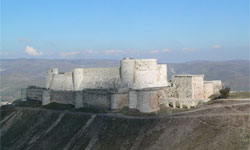 Krak des Chevaliers: T.E. Lawrence once described this castle, located in Syria, as “the best preserved and most wholly admirable castle in the world.” It is the easternmost of a chain of five castles intended to secure the Homs Gap, atop a 650-meter-high hill along the only route from Antioch to Beirut and the Mediterranean Sea. This castle and Beaufort, located in Lebanon as well, were the most important connection castles in the Middle East and they planed a major role in coastal defense for the Crusaders. In 1142 the castle was given by Raymond, Count of Tripoli, to the Knights Hospitallers, and it was they who, during the ensuing fifty years, remodeled and developed it as the most distinguished work of military architecture of its time. The castle remains one of the most complete pieces of military architecture dating from this period, and it holds some of the best preserved Crusader frescoes in the world. The complex contains two concentric walls that sandwich a ditch. The outer wall is an impressive three meters in width, and originally featured a dry moat and drawbridge and was designed to be able to withstand a siege lasting up to five years. Three of the eight round towers were built following the Crusades. Additionally, a chapel within this complex was later converted into a mosque.
Krak des Chevaliers: T.E. Lawrence once described this castle, located in Syria, as “the best preserved and most wholly admirable castle in the world.” It is the easternmost of a chain of five castles intended to secure the Homs Gap, atop a 650-meter-high hill along the only route from Antioch to Beirut and the Mediterranean Sea. This castle and Beaufort, located in Lebanon as well, were the most important connection castles in the Middle East and they planed a major role in coastal defense for the Crusaders. In 1142 the castle was given by Raymond, Count of Tripoli, to the Knights Hospitallers, and it was they who, during the ensuing fifty years, remodeled and developed it as the most distinguished work of military architecture of its time. The castle remains one of the most complete pieces of military architecture dating from this period, and it holds some of the best preserved Crusader frescoes in the world. The complex contains two concentric walls that sandwich a ditch. The outer wall is an impressive three meters in width, and originally featured a dry moat and drawbridge and was designed to be able to withstand a siege lasting up to five years. Three of the eight round towers were built following the Crusades. Additionally, a chapel within this complex was later converted into a mosque.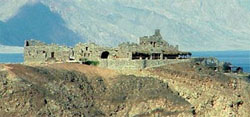 Castle Zaman: Castle Zaman is perched atop a desert cliff midway between Taba and Nuweiba in Sinai. The simple architecture provides amazing views over the Gulf of Aqaba, and into Israel, Jordan, Saudi Arabia, and Egypt. The exact site signifies a landmark on the ancient road that connected St. Catherine’s Monastery with Jerusalem. But, while a distant perspective might fool your eyes into believing this is an ancient ruin, Castle Zaman was built along a local theme to accommodate the contemporary tourist market. Used for honeymooners, parties, film or fashion shootings, the castle and its amenities are available for rent on a weekly or daily basis depending upon availability. Zaman’s private beach, with its pristine sand and crystal clear waters, is the only virgin beach left in the Taba and Nuweiba area.
Castle Zaman: Castle Zaman is perched atop a desert cliff midway between Taba and Nuweiba in Sinai. The simple architecture provides amazing views over the Gulf of Aqaba, and into Israel, Jordan, Saudi Arabia, and Egypt. The exact site signifies a landmark on the ancient road that connected St. Catherine’s Monastery with Jerusalem. But, while a distant perspective might fool your eyes into believing this is an ancient ruin, Castle Zaman was built along a local theme to accommodate the contemporary tourist market. Used for honeymooners, parties, film or fashion shootings, the castle and its amenities are available for rent on a weekly or daily basis depending upon availability. Zaman’s private beach, with its pristine sand and crystal clear waters, is the only virgin beach left in the Taba and Nuweiba area.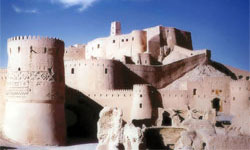 Arg-é Bam Castle: This enormous citadel, situated on the famous Silk Road, was built some time before 500 BCE and remained in use until 1850 CE. It is not known for certain why it was then abandoned. Located in Bam, Iran, this castle is the largest adobe building in the world. The entire building was a large fortress in whose heart the citadel itself was located, but because of the impressive look of the citadel, which forms the highest point, the entire fortress is named the Bam Citadel. It is listed by UNESCO as part of the World Heritage Site, but an earthquake in 2003 destroyed more than 80 percent of the buildings. However, since it is a World Heritage site, several countries - including Japan, Italy, and France - have joined forces to reconstruct the buildings. The World Bank has also granted a large sum of money to the restoration project.
Arg-é Bam Castle: This enormous citadel, situated on the famous Silk Road, was built some time before 500 BCE and remained in use until 1850 CE. It is not known for certain why it was then abandoned. Located in Bam, Iran, this castle is the largest adobe building in the world. The entire building was a large fortress in whose heart the citadel itself was located, but because of the impressive look of the citadel, which forms the highest point, the entire fortress is named the Bam Citadel. It is listed by UNESCO as part of the World Heritage Site, but an earthquake in 2003 destroyed more than 80 percent of the buildings. However, since it is a World Heritage site, several countries - including Japan, Italy, and France - have joined forces to reconstruct the buildings. The World Bank has also granted a large sum of money to the restoration project.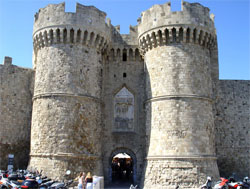 Rhodes Castle: The Island of Roses, or Rhodes, is famous for its historic Medieval town, great shopping, and the site of the Colossus of Rhodes. This ‘castle’ was built within the Old Town walls at the beginning of the 13th century CE by the Knights of St. John of Jerusalem. The building is comprised of 205 rooms and a conference area that hosts summits for European and world leaders. Today it attracts visitors from around the world as it houses the Archaeological Museum of Rhodes. Rhodes lies between Crete and the near East along the Aegean ocean. It is the largest of the Dodecanese islands and popular even among the Greeks as a holiday retreat. Rhodes holds about sixty thousand permanent residents, and it is the financial and cultural center of the southeastern Aegean area. The excellent tourist infrastructure that includes a wide variety of entertainment makes Rhodes a popular destination.
Rhodes Castle: The Island of Roses, or Rhodes, is famous for its historic Medieval town, great shopping, and the site of the Colossus of Rhodes. This ‘castle’ was built within the Old Town walls at the beginning of the 13th century CE by the Knights of St. John of Jerusalem. The building is comprised of 205 rooms and a conference area that hosts summits for European and world leaders. Today it attracts visitors from around the world as it houses the Archaeological Museum of Rhodes. Rhodes lies between Crete and the near East along the Aegean ocean. It is the largest of the Dodecanese islands and popular even among the Greeks as a holiday retreat. Rhodes holds about sixty thousand permanent residents, and it is the financial and cultural center of the southeastern Aegean area. The excellent tourist infrastructure that includes a wide variety of entertainment makes Rhodes a popular destination.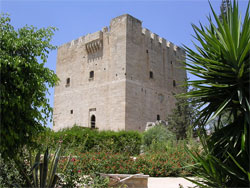 Kolossi Castle: The Kolossi Castle is stronghold located a few kilometers outside the city of Limassol on the island of Cyprus. It held a great strategic importance and contained production of sugar, one of Cyprus’ main exports in the Middle Ages. The original castle was built about 1210 by Frankish military when the land of Kolossi was given by King Hugh I to the Knights of the Order of St John of Jerusalem (Hospitallers). It is a stone fortress and the baseground was probably used as a store with two underground cisterns. You’ll enter the first floor via a suspended bridge, and on the south wall of one of the two lower rooms there is a wall painting representing the Crucifixion of Jesus Christ and the Blason Magnac, which is testimony to the royal devotional use of this room. The next room with the fireplace was likely to be the main dining and reception room. On the second floor there are two more rooms, which were used for lodging. On the roof of the monument, a scalding bowl and loopholes bring the thought of the visitor back to medieval sieges, along with the thought of boiling oil. Former inhabitants of this castle include Richard the Lionhearted and the Knights Templar.
Kolossi Castle: The Kolossi Castle is stronghold located a few kilometers outside the city of Limassol on the island of Cyprus. It held a great strategic importance and contained production of sugar, one of Cyprus’ main exports in the Middle Ages. The original castle was built about 1210 by Frankish military when the land of Kolossi was given by King Hugh I to the Knights of the Order of St John of Jerusalem (Hospitallers). It is a stone fortress and the baseground was probably used as a store with two underground cisterns. You’ll enter the first floor via a suspended bridge, and on the south wall of one of the two lower rooms there is a wall painting representing the Crucifixion of Jesus Christ and the Blason Magnac, which is testimony to the royal devotional use of this room. The next room with the fireplace was likely to be the main dining and reception room. On the second floor there are two more rooms, which were used for lodging. On the roof of the monument, a scalding bowl and loopholes bring the thought of the visitor back to medieval sieges, along with the thought of boiling oil. Former inhabitants of this castle include Richard the Lionhearted and the Knights Templar.
Asia
Like the Middle East, you can find maps that show castle locations throughout Asia. One map, which illustrates castle locations in Japan, clearly demonstrates the proliferation of these Oriental castles in the southern region of the islands. You also can learn about Japanese castles on a site written by a person who has visited over thirty Japanese castles. Maps for Chinese castles are few and far between, but this country’s marvelous architectural structures are beginning to enjoy global attention. Korea also holds a number of castles. Most of these buildings were created as fortresses with entire cities built within their enclosures, but many ‘castles’ in this region consist of temple-cities as well.
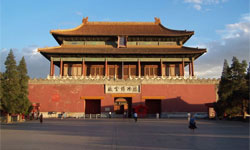 Forbidden City: As the seat of supreme power for over five centuries from 1416 to 1911, the Forbidden City in Beijing, China, contains four high towers on the four corners of the city wall. This is a fort that contains a city, and the walls are approximately one meter thick. Landscaped gardens and many buildings (whose nearly 10,000 rooms contain furniture and works of art), constitute a priceless testimony to Chinese civilization during the Ming and Qing dynasties. The Imperial Palace of the Qing Dynasty in Shenyang consists of 114 buildings constructed between 1625–26 and 1783. It contains an important library and testifies to the foundation of the last dynasty that ruled China before it expanded its power to the center of the country and moved the capital to Beijing. This palace then became auxiliary to the Imperial Palace in Beijing.
Forbidden City: As the seat of supreme power for over five centuries from 1416 to 1911, the Forbidden City in Beijing, China, contains four high towers on the four corners of the city wall. This is a fort that contains a city, and the walls are approximately one meter thick. Landscaped gardens and many buildings (whose nearly 10,000 rooms contain furniture and works of art), constitute a priceless testimony to Chinese civilization during the Ming and Qing dynasties. The Imperial Palace of the Qing Dynasty in Shenyang consists of 114 buildings constructed between 1625–26 and 1783. It contains an important library and testifies to the foundation of the last dynasty that ruled China before it expanded its power to the center of the country and moved the capital to Beijing. This palace then became auxiliary to the Imperial Palace in Beijing.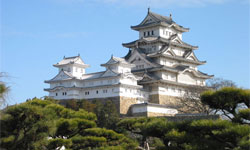 Himeji Castle: Himeji Castle was originally built in 1346 by Akamatsu Sadanori as a fortification against local shoguns. However, the castle has never seen battle, so it is the best preserved example of medieval castle architecture in all of Japan. Himeji is a hill castle that employs the surrounding geography as a bulwark against an enemy attack. The three moats - inner, middle, and outer - served as three lines of defense. The building has expanded over the centuries, and now stands intact on a hill in the center of Himeji City. It is surrounded by a tangled network of spiraling paths and high white walls and, in Japan, it is known as ‘White Heron Castle.’ In 1931 it was designated a national treasure. After several aborted attempts, restoration work began in 1956 and was completed in 1964. It 1993 it was put on the list of UNESCO World Cultural and Heritage Sites. The castle is said to be haunted by a servant girl named Okiku, who is said to have spurned a wealthy warlord’s attention in favor of her true love.
Himeji Castle: Himeji Castle was originally built in 1346 by Akamatsu Sadanori as a fortification against local shoguns. However, the castle has never seen battle, so it is the best preserved example of medieval castle architecture in all of Japan. Himeji is a hill castle that employs the surrounding geography as a bulwark against an enemy attack. The three moats - inner, middle, and outer - served as three lines of defense. The building has expanded over the centuries, and now stands intact on a hill in the center of Himeji City. It is surrounded by a tangled network of spiraling paths and high white walls and, in Japan, it is known as ‘White Heron Castle.’ In 1931 it was designated a national treasure. After several aborted attempts, restoration work began in 1956 and was completed in 1964. It 1993 it was put on the list of UNESCO World Cultural and Heritage Sites. The castle is said to be haunted by a servant girl named Okiku, who is said to have spurned a wealthy warlord’s attention in favor of her true love.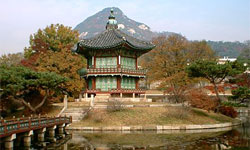 Gyeongbokgung or Gyeongbok Palace: While Seoul, Korea, contains five castles (or, palaces), this building may be the largest and most spectacular palace in Korea. It was originally built in 1395 by Korean architect Do-jeon. King Taejo then added on to the building to make it the main palace of the Joseon dynasty. The Japanese burned the building during an invasion in 1592, and it was left in ruins until King Gojong restored the area in 1868. At one time there were 330 buildings in the palace complex. Many of these are being reconstructed. It is said that the Korean alphabet, known as Hangeul, was created inside this palace during the fifteenth century under the reign of King Sejong.
Gyeongbokgung or Gyeongbok Palace: While Seoul, Korea, contains five castles (or, palaces), this building may be the largest and most spectacular palace in Korea. It was originally built in 1395 by Korean architect Do-jeon. King Taejo then added on to the building to make it the main palace of the Joseon dynasty. The Japanese burned the building during an invasion in 1592, and it was left in ruins until King Gojong restored the area in 1868. At one time there were 330 buildings in the palace complex. Many of these are being reconstructed. It is said that the Korean alphabet, known as Hangeul, was created inside this palace during the fifteenth century under the reign of King Sejong. Angkor Wat: The ruins of Angkor Wat are located amid forests and farmland to the north of the Great Lake (Tonle Sap) and south of the Kulen Hills, near modern day Siem Reap in Cambodia. Although not a castle per se, Angkor represents the seat of the Khmer empire that flourished in this region from approximately the ninth to fifteenth centuries. This period of rule began when the Khmer Hindu monarch Jayavarman II declared himself the “universal monarch” and “god-king” of Cambodia in about 802 CE until 1431 CE, when Thai invaders sacked the Khmer capital and caused its population to migrate south to the Phnom Penh area. The temples are now a UNESCO World Heritage Site, and the main building, Angkor Wat, is said to be the world’s largest single religious monument. Many of the temples at Angkor have been restored, and together they comprise the most significant site for Khmer architecture. With the help of satellite photographs and other techniques, an international team of researchers concluded in 2007 that Angkor Wat was the largest preindustrial city in the world, with an urban sprawl of 1,150 square miles. The closest rival would have been the Mayan city of Tikal in Guatemala, which was roughly fifty square miles in total size.
Angkor Wat: The ruins of Angkor Wat are located amid forests and farmland to the north of the Great Lake (Tonle Sap) and south of the Kulen Hills, near modern day Siem Reap in Cambodia. Although not a castle per se, Angkor represents the seat of the Khmer empire that flourished in this region from approximately the ninth to fifteenth centuries. This period of rule began when the Khmer Hindu monarch Jayavarman II declared himself the “universal monarch” and “god-king” of Cambodia in about 802 CE until 1431 CE, when Thai invaders sacked the Khmer capital and caused its population to migrate south to the Phnom Penh area. The temples are now a UNESCO World Heritage Site, and the main building, Angkor Wat, is said to be the world’s largest single religious monument. Many of the temples at Angkor have been restored, and together they comprise the most significant site for Khmer architecture. With the help of satellite photographs and other techniques, an international team of researchers concluded in 2007 that Angkor Wat was the largest preindustrial city in the world, with an urban sprawl of 1,150 square miles. The closest rival would have been the Mayan city of Tikal in Guatemala, which was roughly fifty square miles in total size.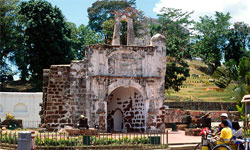 Malacca A’Famosa: When you go to the Web site linked here, you might wonder where the castle went. Well, for the most part, all that’s left of this sixteenth-century Portuguese fort is a tiny gate called the Porta de Santiago. In 1511 a Portuguese fleet arrived in what was then known as Melaka in Malaysia, under the command of Alfonso de Albuquerque. His forces attacked and successfully defeated the armies of the native Sultanate, and Albuquerque built a fortress near the sea. This commander believed that Melaka would become an important link between Portugal and China along the Spice Route. As Melaka’s population grew, the fort was expanded around 1586. The fort changed hands in 1641 when the Dutch drove the Portuguese out of Malaysia. The property changed hands once again in the early nineteenth century when the Dutch handed it over the British to prevent Melaka from falling into Napoleon’s hands. Knowing that they would need to hand the property back to the Dutch at the end of the Napoleonic wars, the British tried to make the entire city useless. Sir Stanford Raffles, Singapore’s founder, convinced the British to allow the population to remain, but all that remains of the buildings was the gate that stands today.
Malacca A’Famosa: When you go to the Web site linked here, you might wonder where the castle went. Well, for the most part, all that’s left of this sixteenth-century Portuguese fort is a tiny gate called the Porta de Santiago. In 1511 a Portuguese fleet arrived in what was then known as Melaka in Malaysia, under the command of Alfonso de Albuquerque. His forces attacked and successfully defeated the armies of the native Sultanate, and Albuquerque built a fortress near the sea. This commander believed that Melaka would become an important link between Portugal and China along the Spice Route. As Melaka’s population grew, the fort was expanded around 1586. The fort changed hands in 1641 when the Dutch drove the Portuguese out of Malaysia. The property changed hands once again in the early nineteenth century when the Dutch handed it over the British to prevent Melaka from falling into Napoleon’s hands. Knowing that they would need to hand the property back to the Dutch at the end of the Napoleonic wars, the British tried to make the entire city useless. Sir Stanford Raffles, Singapore’s founder, convinced the British to allow the population to remain, but all that remains of the buildings was the gate that stands today.
North America
Yes, Virginia - castles do exist in North America. Canada holds the largest castles on this continent, but there is something to be said about a castle that’s small enough to serve as a fishing camp. The following five castles represent a handful of approximately one hundred castles scattered throughout this continent.
 Chapultepec Castle: When you’re in Mexico City, Mexico, look up on the tallest point in the middle of Chapultepec Park. You’ll discover a building that has been used as a military academy, an imperial palace, an observatory, and a museum. It currently houses the Mexican National Museum of History, but you may recognize it as the 1996 film location for the Academy Award-nominated movie, William Shakespeare’s Romeo + Juliet starring Leonardo DiCaprio. It is the only castle in North America that was occupied by European sovereigns. Viceroy Bernardo de Gálvez ordered the construction of a country house on Chapultepec Hill in 1785. After a series of misfortunes and conspiricies, the municipal government of Mexico City purchased the building in 1806. The building went through more occupations and periods of disuse before President Lázaro Cárdenas decreed a law that established Chapultepec Castle as the seat of the National Museum of History (Museo Nacional de Historia) with the collections of the former National Museum of Archaeology, History and Ethnography.
Chapultepec Castle: When you’re in Mexico City, Mexico, look up on the tallest point in the middle of Chapultepec Park. You’ll discover a building that has been used as a military academy, an imperial palace, an observatory, and a museum. It currently houses the Mexican National Museum of History, but you may recognize it as the 1996 film location for the Academy Award-nominated movie, William Shakespeare’s Romeo + Juliet starring Leonardo DiCaprio. It is the only castle in North America that was occupied by European sovereigns. Viceroy Bernardo de Gálvez ordered the construction of a country house on Chapultepec Hill in 1785. After a series of misfortunes and conspiricies, the municipal government of Mexico City purchased the building in 1806. The building went through more occupations and periods of disuse before President Lázaro Cárdenas decreed a law that established Chapultepec Castle as the seat of the National Museum of History (Museo Nacional de Historia) with the collections of the former National Museum of Archaeology, History and Ethnography.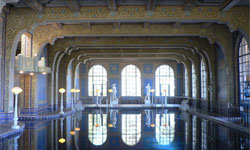 Hearst Castle: On the other side of the U.S. in California, you can find the home of newspaper baron William Randolph Hearst. Located halfway between San Francisco and Los Angeles, construction on this home began in 1919 on a 40,000 acre ranch that Hearst inherited from his father, George Hearst, and that was purchased originally in 1865. San Francisco architect Julia Morgan designed most of the buildings, but the estate was never completed during Hearst’s lifetime. He would tear down structures and rebuild them at a whim, making it difficult to complete the estate while Hearst had a hand in it. Additionally, the estate is a mix of architectural fancies that Hearst enjoyed on his European trips. The facade is modeled after a sixteenth-century Spanish cathedral, while the outdoor pool features an ancient Roman temple front that was transported wholesale from Europe and reconstructed at the site. The indoor pool, shown here, is modeled after Roman baths with gold mosaic tiles. The castle was donated by the Hearst Corporation to the state of California in 1957, and it is a Sate Historical Monument and a National Historic Landmark open for public tours.
Hearst Castle: On the other side of the U.S. in California, you can find the home of newspaper baron William Randolph Hearst. Located halfway between San Francisco and Los Angeles, construction on this home began in 1919 on a 40,000 acre ranch that Hearst inherited from his father, George Hearst, and that was purchased originally in 1865. San Francisco architect Julia Morgan designed most of the buildings, but the estate was never completed during Hearst’s lifetime. He would tear down structures and rebuild them at a whim, making it difficult to complete the estate while Hearst had a hand in it. Additionally, the estate is a mix of architectural fancies that Hearst enjoyed on his European trips. The facade is modeled after a sixteenth-century Spanish cathedral, while the outdoor pool features an ancient Roman temple front that was transported wholesale from Europe and reconstructed at the site. The indoor pool, shown here, is modeled after Roman baths with gold mosaic tiles. The castle was donated by the Hearst Corporation to the state of California in 1957, and it is a Sate Historical Monument and a National Historic Landmark open for public tours.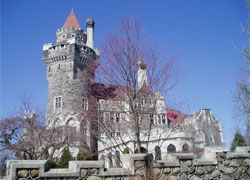 Casa Loma: Located in Toronto, Ontario, Canada, this castle was the former estate of Sir Henry Pellatt, a prominent Toronto financier, industrialist and military man. Construction on this castle began in 1911, and it took 300 men and nearly 3 years to complete at a price of over three million dollars. Pellatt enjoyed the castle for about one decade before he declared financial ruin. The city seized Casa Loma in 1933 for $27,303 in back taxes. While one critic called the mansion “a mixture of 17th century Scotland and 20th Century Fox,” many visitors tour the decorated suites, secret passages, an 800-foot tunnel, towers, stables, and five-acre estate gardens. The house was commissioned to Canadian architect. E.J. Lennox and, at 98 rooms, it was the largest private residence in North America upon completion. Many of the rooms were left unfinished, and today serve as the Regimental Museum for The Queen’s Own Rifles of Canada.
Casa Loma: Located in Toronto, Ontario, Canada, this castle was the former estate of Sir Henry Pellatt, a prominent Toronto financier, industrialist and military man. Construction on this castle began in 1911, and it took 300 men and nearly 3 years to complete at a price of over three million dollars. Pellatt enjoyed the castle for about one decade before he declared financial ruin. The city seized Casa Loma in 1933 for $27,303 in back taxes. While one critic called the mansion “a mixture of 17th century Scotland and 20th Century Fox,” many visitors tour the decorated suites, secret passages, an 800-foot tunnel, towers, stables, and five-acre estate gardens. The house was commissioned to Canadian architect. E.J. Lennox and, at 98 rooms, it was the largest private residence in North America upon completion. Many of the rooms were left unfinished, and today serve as the Regimental Museum for The Queen’s Own Rifles of Canada.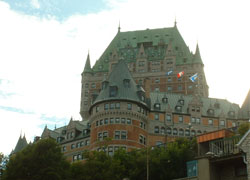 Frontenac Castle: The Frontenac Castle is actually a Fairmont Hotel that is located in Quebec City, Quebec, Canada, about one-half mile from Quebec’s parliament. Although the Fairmont Le Château Frontenac is actually a hotel, it is as symbolic to Quebec as the Eiffel Tower is to Paris. This Renaissance style castle was build in less than a century by the Canadian Pacific Railway company. With its castle-like architecture and turrets, Fairmont Le Château Frontenac plays a huge role in the heart of the city’s activities, and it has been designated a United Nations World Heritage Site. It may be difficult to book a room in 2008, as this year represents Quebec’s 400th anniversary.
Frontenac Castle: The Frontenac Castle is actually a Fairmont Hotel that is located in Quebec City, Quebec, Canada, about one-half mile from Quebec’s parliament. Although the Fairmont Le Château Frontenac is actually a hotel, it is as symbolic to Quebec as the Eiffel Tower is to Paris. This Renaissance style castle was build in less than a century by the Canadian Pacific Railway company. With its castle-like architecture and turrets, Fairmont Le Château Frontenac plays a huge role in the heart of the city’s activities, and it has been designated a United Nations World Heritage Site. It may be difficult to book a room in 2008, as this year represents Quebec’s 400th anniversary.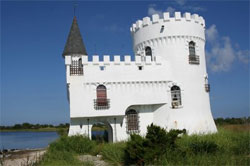 Fisherman’s Castle: Anyone who’s driven along I-10 between the Mississippi-Louisiana border and New Orleans in the United States has seen this small and simple castle sitting on the other side of Irish Bayou. Contractor Simon Villemarrette built the ‘home’ in 1981 and he based it upon a fourteenth-century French castle. He purposely built the castle with round turrets and with enough concrete to withstand 140 mph wind gusts. Unfortunately, Villemarrette died before he could occupy the home. This building did survive Hurricane Katrina in 2005 with little damage other than the chunks cut from the sides by flying debris. Jon Digman currently resides in the home as a caretaker, but it’s unknown who owns the home or what the future of this castle holds. The image shown here was taken in 2007, so it’s obvious that any damage created by Hurricane Katrina has been repaired. This little replica goes to show that any home can be a castle.
Fisherman’s Castle: Anyone who’s driven along I-10 between the Mississippi-Louisiana border and New Orleans in the United States has seen this small and simple castle sitting on the other side of Irish Bayou. Contractor Simon Villemarrette built the ‘home’ in 1981 and he based it upon a fourteenth-century French castle. He purposely built the castle with round turrets and with enough concrete to withstand 140 mph wind gusts. Unfortunately, Villemarrette died before he could occupy the home. This building did survive Hurricane Katrina in 2005 with little damage other than the chunks cut from the sides by flying debris. Jon Digman currently resides in the home as a caretaker, but it’s unknown who owns the home or what the future of this castle holds. The image shown here was taken in 2007, so it’s obvious that any damage created by Hurricane Katrina has been repaired. This little replica goes to show that any home can be a castle.
Around the World
The following castles aren’t as grand as those found in Europe or even in the Middle East or in Asia. But, for their owners and inhabitants, they represented all that was powerful, protective, and princely. And, the castle in Colombia, South America, would rival many European castles in sheer size. Many of the ‘castles’ located around the Caribbean were forts that housed a city complex complete with soldiers. On the other hand, some of the castles shown here were meant as private homes. Yet, these latter buildings are spacious enough to host large functions.
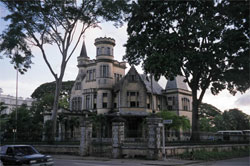 Stollmeyer’s Castle: Modeled after a wing of Balmoral Castle in Scotland, and created by the Scottish architect, Robert Gillies from the firm of Taylor and Gillies, this fantastic residence is definitely under Scottish influence. However, it’s located far from Scotland, as the home is located in Port-of-Spain in Trinidad. The wife of the original builder, Charles Fourier Stollmeyer, did not like the house, so it was passed to the Stollmeyer’s son, Conrad C. Stollmeyer. Mr. and Mrs. Conrad Stollmeyer lived at the house until their deaths in the 1960s, and the house then passed to the Stollmeyers’ only son, Dr. John Stollmeyer. In March, 1972, John Stollmeyer sold the home for $215,000 to Jesse Henry A. Mahabir, an insurance executive. The building was to be used for residential purposes only. The building was acquired from Mr. Mahabir by the Trinidad and Tobago Government in 1979. If you’re visiting Trinidad and Tobago, you might want to take in this home as well as six others that make up this country’s Magnificent Seven architectural treasures.
Stollmeyer’s Castle: Modeled after a wing of Balmoral Castle in Scotland, and created by the Scottish architect, Robert Gillies from the firm of Taylor and Gillies, this fantastic residence is definitely under Scottish influence. However, it’s located far from Scotland, as the home is located in Port-of-Spain in Trinidad. The wife of the original builder, Charles Fourier Stollmeyer, did not like the house, so it was passed to the Stollmeyer’s son, Conrad C. Stollmeyer. Mr. and Mrs. Conrad Stollmeyer lived at the house until their deaths in the 1960s, and the house then passed to the Stollmeyers’ only son, Dr. John Stollmeyer. In March, 1972, John Stollmeyer sold the home for $215,000 to Jesse Henry A. Mahabir, an insurance executive. The building was to be used for residential purposes only. The building was acquired from Mr. Mahabir by the Trinidad and Tobago Government in 1979. If you’re visiting Trinidad and Tobago, you might want to take in this home as well as six others that make up this country’s Magnificent Seven architectural treasures.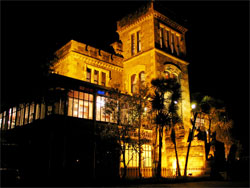 Larnach Castle: Visiting New Zealand? If you plan to spend any time in this area, then you’ll want to visit this country’s one and only castle. Australian-born William Larnach, merchant baron and politician, built this home for for his first wife in 1871. Over 200 workmen spent three years building the Castle shell and master European craftsmen spent a further 12 years embellishing the interior. Larnach spared no expense on this dream home, which features the finest materials from around the world. The building is the centerpiece of a 35-acre property atop a hill midway along the Otago Peninsula, eight miles from the city of Dunedin on the east cost of the country’s South Island. Still privately owned, the Barker family celebrated their 40th anniversary with Larnach Castle in 2007. Weddings, balls, official and formal functions and celebrations are held often in the home’s 3,000 square foot ballroom. But, be aware that this castle is haunted by both the first and second Mrs. Larnachs, and daughter Katie. The specter of Larnach himself might linger, as he shot himself in the head in 1898 when he learned that his young third wife was embroiled in an affair with one of Larnach’s sons from his first marriage.
Larnach Castle: Visiting New Zealand? If you plan to spend any time in this area, then you’ll want to visit this country’s one and only castle. Australian-born William Larnach, merchant baron and politician, built this home for for his first wife in 1871. Over 200 workmen spent three years building the Castle shell and master European craftsmen spent a further 12 years embellishing the interior. Larnach spared no expense on this dream home, which features the finest materials from around the world. The building is the centerpiece of a 35-acre property atop a hill midway along the Otago Peninsula, eight miles from the city of Dunedin on the east cost of the country’s South Island. Still privately owned, the Barker family celebrated their 40th anniversary with Larnach Castle in 2007. Weddings, balls, official and formal functions and celebrations are held often in the home’s 3,000 square foot ballroom. But, be aware that this castle is haunted by both the first and second Mrs. Larnachs, and daughter Katie. The specter of Larnach himself might linger, as he shot himself in the head in 1898 when he learned that his young third wife was embroiled in an affair with one of Larnach’s sons from his first marriage.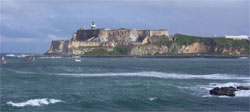 Castillo San Felipe del Morro: Over two million visitors a year explore theme windswept ramparts and pageways in this fortress/castle, where the history of 400 years of Spain in Puerto Rico comes alive. Begun in 1539 by Spanish settlers to defend the port of San Juan, El Morro’s architecture follows well established Spanish military fortification design principles. Similar Spanish fortifications from the seventeenth and eighteenth centuries can be seen on islands throughout the Caribbean and in Florida in the U.S. Named in honor of King Philip II of Spain, the Castillo was declared a World Heritage Site by the United Nations in 1983 and is part of San Juan National Historic Site.
Castillo San Felipe del Morro: Over two million visitors a year explore theme windswept ramparts and pageways in this fortress/castle, where the history of 400 years of Spain in Puerto Rico comes alive. Begun in 1539 by Spanish settlers to defend the port of San Juan, El Morro’s architecture follows well established Spanish military fortification design principles. Similar Spanish fortifications from the seventeenth and eighteenth centuries can be seen on islands throughout the Caribbean and in Florida in the U.S. Named in honor of King Philip II of Spain, the Castillo was declared a World Heritage Site by the United Nations in 1983 and is part of San Juan National Historic Site.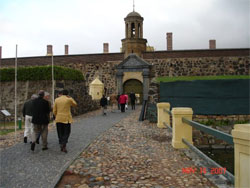 Castle of Good Hope: The Castle of Good Hope was built in Cape Town, South Africa, between between 1666 and 1679, which makes this castle complex the oldest surviving building in this region. The current pentagonal fortification replaced a small clay and timber fort built by Commander Jan van Riebeeck in 1652 upon establishing a maritime replenishment station art the Cape of Good Hope for the Dutch East India Company, better known as the VOC (Verenigde Oos-Indische Compagnie). In 1936 the Castle was declared a National Monument. As a result of an extensive, ongoing restoration and conservation program launched in the 1980’s, the Castle of Good Hope remains the best preserved of its kind built by the VOC in regions where it had interests. The Cape of Good Hope houses the regional headquarters of the South African Army in the Western Cape, the famous William Fehr Collection of historic artworks, the Castle Military Museum and ceremonial facilities for traditional Cape Regiments.
Castle of Good Hope: The Castle of Good Hope was built in Cape Town, South Africa, between between 1666 and 1679, which makes this castle complex the oldest surviving building in this region. The current pentagonal fortification replaced a small clay and timber fort built by Commander Jan van Riebeeck in 1652 upon establishing a maritime replenishment station art the Cape of Good Hope for the Dutch East India Company, better known as the VOC (Verenigde Oos-Indische Compagnie). In 1936 the Castle was declared a National Monument. As a result of an extensive, ongoing restoration and conservation program launched in the 1980’s, the Castle of Good Hope remains the best preserved of its kind built by the VOC in regions where it had interests. The Cape of Good Hope houses the regional headquarters of the South African Army in the Western Cape, the famous William Fehr Collection of historic artworks, the Castle Military Museum and ceremonial facilities for traditional Cape Regiments.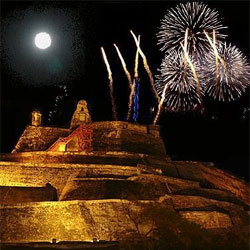 San Felipe Castle: Castillo de San Felipe, Cartagena, Colombia, South America, was founded in 1533. This forted castle is a walled city and a World Heritage site. It took slave labor over a century to build this fortress that dominates the landscape and that protected residents from pirates. The fortress is thought to be Spain’s most successful military engineering project in the Americas. Built from red brick and concrete, this citadel is designed so even if one part of the fortress fell to invaders (which never happened), the defenders could fire from another part. Its size is startling, and visitors begin to realize this building’s magnitude when they begin to explore the underground tunnel network.
San Felipe Castle: Castillo de San Felipe, Cartagena, Colombia, South America, was founded in 1533. This forted castle is a walled city and a World Heritage site. It took slave labor over a century to build this fortress that dominates the landscape and that protected residents from pirates. The fortress is thought to be Spain’s most successful military engineering project in the Americas. Built from red brick and concrete, this citadel is designed so even if one part of the fortress fell to invaders (which never happened), the defenders could fire from another part. Its size is startling, and visitors begin to realize this building’s magnitude when they begin to explore the underground tunnel network.
Bangunan Dengan 1000 Jendela

Sebuah block perkantoran baru di Cina yang sedang dalam pembangunan dimana merupakan desain dari seorang arsitek asal Jepang bernama Sako Keiichiro, dipercaya merupakan bangunan yang memiliki jendela paling banyak sedunia.
Adapun bangunan itu berlantai 9 dan memiliki jendela hampir 1000 buah.
Seorang jurnalis surat kabar setempat bahkan menghitung jumlah jendela tersebut. Mau tahu detailnya?
Menurut penghitungan sang jurnalis, bangunan itu memiliki 113 jendela di 15 ruangan yang ada di lantai 9, dan dalam satu ruangan saja terdapat 21 jendela.
Gak ada satu ruanganpun di bangunan itu yang benar-benar berbentuk persegi empat atau bujur sangkar, terdapat koridor angin disekelilingnya dan di antara ruangan. Dan masing-masing lantai terdapat taman kecil.
"Di dalam seperti menyesatkan," jelas seorang pekerja konstruksi yang juga mengatakan kalau bangunan itu merupakan proyek tersulit dan yang menghabiskan paling banyak waktunya.
Seperti yang diberitakan Ananova.com, bangunan itu membuat orang-orang yang lewat dan melihatnya terlalu lama menjadi pusing.
Wei, kepala konstruksi menjelaskan kalau bangunan itu bakal rampung musim panas tahun ini. Selain itu Wei juga menjelaskan kalau sebuah hotel berlantai 3 juga bakalan di buat dengan desain seperti bangunan perkantoran ini.
Menurut Wei, total pembuatan bangunan perkantoran itu menghabiskan biaya sekitar 6 Juta poundsterling (sekitar Rp 106.547.700.000). Sedang biaya jendela nya sendiri saja berjumlah 500,000 Poundsterling (sekitar Rp 8.878.975.000).
Mystery of The Ghost Solved


The picture was taken by Tony O'Rahilly, a sewage farm worker and keen photographer, as he stood across the road among a crowd watching the 90-year-old building in Wem, Shropshire, burn down in November 1995.
The legend of the Wem Ghost was born. But 15 years on, a pensioner has come forward to cast doubt on the spectre.
Brian Lear, 77, said the 'ghost' bears a distinct likeness to a girl standing in a doorway in a photo of Wem's high street. This was used on a postcard dating from 1922.
Mr Lear, a retired engineer from Shrewsbury, spotted the image when it was reproduced last week as part of a nostalgia item in a local paper.
'I was intrigued to find that she bore a striking likeness to the little girl featured as the Wem Ghost,' he said.
'Her dress, bonnet and ribbon appear to be identical.'
In 1995 the 'ghost' image created international headlines. There was local speculation that the girl was 14-year-old Jane Churm, who accidentally started a disastrous fire in Wem in 1677. The cause of the 1995 fire remains a mystery. Mr O'Rahilly died of a heart attack in 2005.
Local councillor Peggy Carson, who knew him, said she believed the stress caused by interest in his picture contributed to his death.
Local historian Tom Edwards, 69, said: 'He always maintained that the picture was genuine and I believe him.'
Photographic experts have suggested that the 'ghost' image was a trick of the light caused by the fire.
However, Greg Hobson, the curator of photographs at the National Media Museum in Bradford, said: 'The postcard offers pretty conclusive proof that this is a hoax.
'I think we can say the mystery has been solved.'
Mr Hobson said the technique used to produce the doctored photograph was probably similar to one used by Edwardian era mediums who purported to capture images of spirits with their relatives during the relatives' consultations as a way of boosting their credibility.
The mediums would first ask for a photograph of the deceased person, then take a picture of it in the back room. When the client returned later for a consultation, the image would already be partly exposed on to a glass plate.
Another picture would be taken of the client during the session and exposed on to the same plate, giving an image apparently showing the spirit of their relative visiting them during the seance.
Katak Kaca dari Ekuador
Para ilmuwan dari organisasi lingkungan hidup Conservation International (CI) dalam penelitian keragaman hayati di Hutan Lindung Nangaritza Ekuador dekat perbatasan Peru menemukan katak kaca atau kristal yang disebut Hyalinobatrachium pellucidum.
Jenis amfibi ini berukuran lebih kecil dari kuku jari dan berkulit transparan sehingga organ dalamnya tampak dari luar. Satwa ini tergolong terancam punah.
Di lokasi yang sama, peneliti dari CI juga menemukan paling tidak 15 fauna dan flora yang tergolong baru bagi khazanah ilmiah.
Di dunia diperkirakan terdapat 14 juta flora-fauna, yang telah teridentifikasi manusia hanya sekitar 1,8 juta.
Tujuan dari penelitian selama tiga minggu tersebut adalah untuk mengidentifikasi spesies dan menyusun rekomendasi konservasi untuk kemungkinan pengembangan ekowisata di hutan itu.
Mereka juga mengungkapkan bahwa serangga dan katak yang ditemukan berpotensi medis. Survei kelayakan populasi diperlukan untuk melihat potensi lain di hutan itu. (Conservation International)
7 Habits of Highly Successful Teens
For teens, life is not a playground, it's a jungle. And, being the parent of a teenager isn't any walk in the park, either. In his book, The 7 Habits of Highly Effective Teens, author Sean Covey attempts to provide "a compass to help teens and their parents navigate the problems they encounter daily."
How will they deal with peer pressure? Motivation? Success or lack thereof? The life of a teenager is full of tough issues and life-changing decisions. As a parent, you are responsible to help them learn the principles and ethics that will help them to reach their goals and live a successful life.
While it's all well and good to tell kids how to live their lives, "teens watch what you do more than they listen to what you say," Covey says. So practice what you preach. Your example can be very influential.
Covey himself has done well by following a parent's example. His dad, Stephen Covey, wrote the book The 7 Habits of Highly Successful People, which sold over 15 million copies. Sean's a chip off the old block, and no slacker. His own book has rung in a more than respectable 2 million copies sold. Here are his seven habits, and some ideas for helping your teen understand and apply them:
Be Proactive
Being proactive is the key to unlocking the other habits. Help your teen take control and responsibility for her life. Proactive people understand that they are responsible for their own happiness or unhappiness. They don't blame others for their own actions or feelings.
Begin With the End in Mind
If teens aren't clear about where they want to end up in life, about their values, goals, and what they stand for, they will wander, waste time, and be tossed to and fro by the opinions of others. Help your teen create a personal mission statement which will act as a road map and direct and guide his decision-making process.
Put First Things First
This habit helps teens prioritize and manage their time so that they focus on and complete the most important things in their lives. Putting first things first also means learning to overcome fears and being strong during difficult times. It's living life according to what matters most.
Think Win-Win
Teens can learn to foster the belief that it is possible to create an atmosphere of win-win in every relationship. This habit encourages the idea that in any given discussion or situation both parties can arrive at a mutually beneficial solution. Your teen will learn to celebrate the accomplishments of others instead of being threatened by them.
Seek First to Understand, Then to be Understood
Because most people don't listen very well, one of the great frustrations in life is that many don't feel understood. This habit will ensure your teen learns the most important communication skill there is: active listening.
Synergize
Synergy is achieved when two or more people work together to create something better than either could alone. Through this habit, teens learn it doesn't have to be "your way" or "my way" but rather a better way, a higher way. Synergy allows teens to value differences and better appreciate others.
Sharpen the Saw
Teens should never get too busy living to take time to renew themselves. When a teen "sharpens the saw" she is keeping her personal self sharp so that she can better deal with life. It means regularly renewing and strengthening the four key dimensions of life – body, brain, heart, and soul.
17.5.10
5 Makanan Pereda Stress

Daging AyamIkan Salmon Daging sapi yang mengandung vitamin B, zat besi dan Zinc sangat bermanfaat bagi tubuh kita untuk meredakan stress. Sedangkan daging ayam yang mengandung protein dan selenium akan membuat otak lebih berkonsentrasi dan juga dapat mengatur mood seseorang.
2. Ikan

Ikan yang banyak mengandung zat omega 3 dapat meningkatkan zat alamiah dalam tubuh yang dapat menjadi zat pereda stress, sehingga membuat tubuh dan otak lebih rileks. Biasanya ikan-ikan yang banyak mengandung zat omega-3 adalah ikan-ikan yang hidup di laut dalam.
Namun umumnya segala jenis ikan banyak mengandung vitamin B lengkap yang dapat membantu memproduksi zat yang memicu rasa "Bahagia" dan mengirimkan signal itu ke otak. Jadi umumnya orang-orang yang kekurangan vitamin B12 dapat lebih mudah terserang rasa depresi.
3. Sayuran Hijau

KemangiStrawberry Sayuran hijau seperti bayam, kangkung, dan brokoli yang mengandung asam folic yang tinggi sehingga membantu meredakan stress, gelisah, depresi dan perasaan panik lainnya. Ada pula kemangi yang dapat membantu menurunkan kadar hormon pemicu stress di dalam tubuh.
4. Buah-buahan kaya anti oksidan

Buah-buahan yang kaya akan zat anti oksidan seperti bluberry, strawberry, pisang, anggur, dan cherry dapat langsung membantu kita meredakan stress yang melanda. Buah-buahan tersebut kaya akan vitamin C yang berfungsi menstimulasi hormon adrenalin untuk meredakan stress. Bahkan untuk buah Cherry yang mengandung zat anthocyanin berfungsi membantu tubuh menghasilkan perasaan bahagia.
5. Susu

Susu Susu mengandung kalsium dan sebagai anti oksidan yang dapat menghancurkan racun-racun yang masuk kedalam tubuh sehingga memicu stress.
sumber: http://blognyajose.blogspot.com/2010/01/inilah-makanan-pereda-stress-hmm-nyam2.html
Penemuan Paling Menyebalkan
Sebuah jajak pendapat yang diikuti oleh 2,500 orang dewasa di Inggris menemukan bahwa hampir 25 persen responden berharap mesin itu tak pernah ditemukan.
Temuan lain yang tak kalah menyebalkan bagi warga Britania adalah 24 jam saluran televisi olahraga, konsol game komputer, telepon selular dan alarm jam.
Diciptakan pada tahun 1971 oleh seorang musisi Jepang bernama Inoue Daisuke, karaoke, artinya "orkestra kosong". Mesin ini menjadi begitu populer di Asia sebelum akhirnya diperkenalkan ke seluruh dunia pada akhir tahun 1980.
Daisuke tak pernah mempatenkan penemuannya itu yang mengkombinasikan stereo mobil, boks koin dan pengeras suara, sebuah "kesalahan" yang membuatnya menghabiskan dana yang diperkirakan mencapai angka 100 juta Poundsterling.
Kane Kramer, direktur Perkumpulan Penemu Inggris, mengatakan, "Melihat mesin karoke berada di urutan paling atas dari daftar membuat saya tersenyum.
"Ketika orang-orang menyanyi di karoke, saat itu mereka sedang menikmati 'diri sendiri', namun ketika Anda duduk sebagai penonton dan menyaksikan seseorang dengan performa yang jelek, yang benar-benar tak menyenangkan untuk didengar, saat itu baru Anda merasa mesin ini menyebalkan."
Mesin karoke ini diperkenalkan di Britania oleh Ivor Arbiter, yang meninggal pada tahun 2005, dan putrinya Joanne, setelah mereka mengunjungi pameran niaga Jepang pada tahun 1987.
Joanne mengatakan, "Seperti dua sisi mata uang, mungkin kita sebal mendengar orang bersuara parau menyanyi dengan seenaknya, namun melalui mesin ini jutaan orang dapat mengetahui bahwa sebetulnya mereka memiliki talenta menyanyi."
Youfacester: Jaring Sosial Kloning Facebook
JAKARTA - Kepopuleran Facebook rupanya menarik minat salah seorang perancang web Indonesia untuk menciptakan situs jejaring sosial serupa Facebook bernama Youfacester.
Konon, penamaan situs Youfacester yang beralamat di www.youfacester.com ini merupakan paduan dari tiga nama situs jejaring sosial populer yaitu Youtube, Facebook, dan Friendster.
Saat ditelusuri okezone, situs bernama Youfacester ini nampak seperti hasil kloning Facebook. Bahkan si pembuatnya memang sengaja memperkenalkan Youfacester sebagai kloning Facebook. Pada sebelah kiri bawah halaman log in tertulis: Youfacester Indonesian, Facebook Clone Layout.
Jika di halaman log ini Facebook terdapat gambar peta dunia, Youfacester menjiplaknya dengan menyertakan gambar peta Inonesia.
Pengunjung situs jiplakan ini pun nampaknya sudah mulai banyak, meski begitu masih sangat jauh jika dibandingkan dengan jumlah pengunjung situs Facebook atau Friendster.
Bentuk tampilannya memang didesain benar-benar mirip Facebook, namun beberapa aplikasi kontennya memang agak berbeda.
Meski diklaim bahwa situs ini merupakan Facebook-nya Indonesia, Youfacester sendiri masih menggunakan bahasa Inggris.
Menurut kabar, pada akhir Juli nanti akan segera hadir Youfacester dengan versi bahasa Indonesia dan beberapa versi bahasa lainnya. Hingga saat ini belum jelas siapa jati diri si pembuat situs kloning Facebook ini.
Seekor Rubah Curi 120 Sepatu

Seekor rubah betina mencuri lebih dari 100 sepatu di kota Foehren, Jerman, selama satu tahun belakangan.
Tanda gigitan kecil pada sepatu yang dikumpulkan tersebut menunjukkan semua sepatu itu kelihatannya dijadikan mainan oleh anak sang rubah.
Seorang pekerja hutan menemukan sepatu yang berceceran di dekat sarang rubah di kota kecil Foehren di Jerman barat. Pencarian lubang di dekat sarang itu membongkar "harta terpendam berupa tumpukan alas kaki" yang baru-baru ini dicuri pada malam hari melalui pintu depan rumah penduduk setempat.
"Semuanya ada, mulai dari sepatu perempuan sampai sepatu olahraga," kata juru bicara polisi setempat dilansir Xinhua, Senin (15/6). "Kami telah menemukan antara 110 dan 120 sepatu sejauh ini. Ada tanda gigitan kecil pada tali dan renda sepatu. Kelihatannya rubah betina mencuri semua sepatu tersebut buat mainan anaknya."
Nenek 55 Tahun Berenang Sejauh 26 KM

Seorang nenek berusia 55 tahun yang berasal dari tempat wisata Rotorua, North Island, Selandia Baru, berhasil menyeberangi Selat Cook dengan berenang dalam waktu 9 jam 23 menit, dan menjadi orang tertua yang melakukan tindakan tersebut.
Pam Dickson berhasil menempuh 26 kilometer, Jumat (20/3), dalam upaya pertamanya, kendati ia menderita hipotermia dan berenang berkeliling selama 800 meter terakhir karena ia sangat kedinginan dan kebingungan.
Pam mengatakan, temperatur air adalah 18 derajat ketika ia mulai berenang, tapi temperatur kemudian turun menjadi 16 derajat pada empat kilometer terakhir. Pemandunya, perenang kawakan Selat Cook, Philip Rush, mengatakan, tidak sah untuk mengenakan pakaian basah, termasuk di English Channel.
Ia mengatakan, penyeberangan Pam adalah "usaha besar" di tengah angin keras sampai 30 knot, yang membuat keadaan jadi sulit baik bagi perenang maupun awak pendukungnya.
Pam Dickson, ahli urut terapi dan nenek sembilan cucu, mengatakan, ia melompat kegirangan dengan prestasinya, tapi mungkin takkan beristirahat terlalu lama. Ia telah ikut dalam banyak lomba Ironman dan maraton dan sedang mempertimbangkan untuk mengikuti maraton Rotorua pada Mei mendatang.
Harapkan Hujan, Ratusan Orang Hadiri Pernikahan Sepasang Katak
Demikian disebutkan surat kabar lokal berbahasa Bengali, Jugantor, Jumat (27/3). ”Pengantin perempuan” dan ”pengantin laki-laki” datang dari desa tetangga yang berjarak 110 kilometer di sebelah utara Dhaka. Para penduduk desa menyelenggarakan prosesi perkawinan sepasang katak tersebut karena daerah itu kekurangan air. Mereka menantikan datangnya musim hujan. Demikian dikisahkan seorang guru sekolah desa itu, Noor Mohamad Kalon, yang merupakan tamu dari sisi ”pengantin laki-laki”. ”Lebih dari 250 lelaki, perempuan, dan anak-anak menjadi tamu dalam perkawinan itu. Kami berdansa dan menyanyi,” ujar guru berusia 42 tahun itu. Dia menceritakan, dalam pesta perkawinan sang katak itu juga disediakan nasi, ikan, daging, dan manisan. ”Pengantin perempuan dan laki-laki berdandan dengan baju bagus. Kami memberi mereka berkat lalu melepaskan keduanya di kolam. Tadi malam sudah turun hujan, saya percaya itu akibat perkawinan kedua katak,” ungkapnya.
Lebih dari 250 orang di daerah Banglades Utara menghadiri perkawinan dua katak. Perkawinan kedua katak itu dimaksudkan agar dapat mendatangkan hujan di kawasan tersebut.
Kartu Pos Itu Tiba 47 Tahun Kemudian
Sebuah kartu pos yang dikirim seorang perempuan dari Negara Bagian Montana di barat laut AS memerlukan waktu 47 tahun untuk sampai ke Negara Bagian Ohio di timur laut AS. Kartu pos ucapan selamat ini ditemukan saat agen asuransi Dave Conn membuka kotak pos di Hudson, Ohio, pekan lalu dan menemukan kartu pos yang dikirim dari Helena, Montana, tahun 1962.
Kartu pos itu dikirim ke Marion White, penyewa kotak pos itu sebelumnya. White sudah meninggal dunia tahun 1988. Pada kartu pos tersebut, si penulis membubuhkan paraf ”Fran” sembari mengisahkan kehidupannya yang menyenangkan di Montana.
Setelah bertanya sana-sini, Conn memastikan kartu pos tersebut dikirim oleh Frances Murphey, teman perempuan White yang juga wartawan pada Akron Beacon Journal. Murphey meninggal dunia tahun 1998 pada usia 75 tahun.
Juru bicara Pos AS, Victor Dubina, mengemukakan, kartu pos ini kemungkinan terselip atau tertinggal di dalam kantong surat. Entah apa nasib selanjutnya dari kartu pos ini. Si pengirim dan penerimanya sudah meninggal dunia. Mungkin jadi koleksi kartu pos dari tahun 1960-an bagi Conn.
Blog Design by Gisele Jaquenod





















